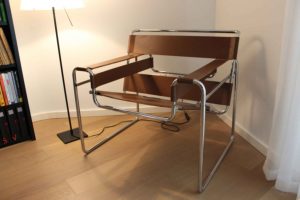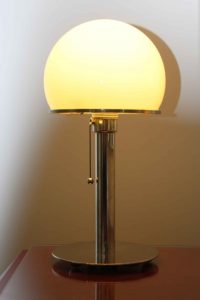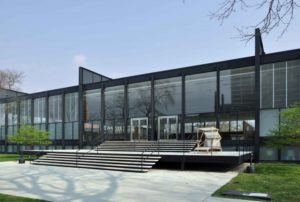Bauhaus, the art of aesthetic harmony, launched its global success almost a century ago. To this day, Bauhaus shapes our daily lives, our architecture, design and sense of style. Through its German-Jewish emigrants, Bauhaus dominates the urban landscape of the “White City” Tel Aviv. Let’s look at the very beginnings of the movement – almost 100 years ago in the small Thuringian town of Weimar…
The story has a happy end. Although, for a while, it seemed unlikely. In 1919, all eyes were on Weimar, the tiny town in the heart of Thuringia. The German National Assembly had withdrawn here from the revolutionary hotbed of the Capital, Berlin. It had gathered to draw up a constitution in the “Spirit of Weimar” – home of venerated poets and thinkers like Goethe, Schiller, Wieland, and Herder. It was a spirit Germans conjured up to contrast the monstrosities of WWI. The constitution was to be that of a republic, the first on German soil.
Whilst the assembly noodled over details, Walter Gropius, a 36 year old architect, signed the contract making him director of the new Weimar Art School, the State Bauhaus. Weimar democracy was to last a mere 14 years before it was strangled by Hitler’s Nazis. Its demise was also to be the end of the Bauhaus. As a flagship of modernity this school was anathema to the Nazis. But German democracy came back to stay. And after its closure in Germany, the Bauhaus went global. It, too, is here to stay – defining style, taste and everyday life worldwide. And in 2019, the Bauhaus will be celebrating its centenary!

Wassily chair by Marcel Breuer
Its founding director Walter Gropius had dropped out of architecture school. Good looking and highly-decorated in WWI for valor at the front, Gropius had already made his mark with revolutionary designs like a factory building for shoe last producer Fagus in Alfeld near Hanover. Now, Weimar was calling. In early 1919, the local Art School and the School of Arts and Crafts, both renowned institutions, had merged to create what would later become known as “the Bauhaus.”
This clearly called for a manifesto. Its opening sentence was a bombshell: “The ultimate goal of all art is the building!” Gropius went on to demand: “Architects, sculptors, painters – we all must return to craftsmanship! For there is no such thing as ‘art by profession’. There is no essential difference between the artist and the artisan. The artist is an exalted artisan.” Expressionistically intoxicated, he continued: “Let us strive for, conceive, and create the new building of the future that will unite every discipline, architecture and sculpture and painting, and which will one day rise heavenwards from the million hands of craftsmen as a clear symbol of a new belief to come.”

The Wagenfeld lamp
Well, reality was a different thing. 1919 meant hard times. The economy was stalling, provisions were scarce. Soon students and teachers complained about the lack of materials, freezing cold working spaces, frugal meals. But Gropius was a highly gifted administrator, fund raiser, and organizer – and a talent scout. Within a very short time period, he persuaded the crème de la crème of the avant-garde to sign up as Bauhaus teachers: Lyonel Feininger, Johannes Itten, Wassily Kandinsky, Paul Klee, Gerhard Marcks, Oskar Schlemmer, and László Moholy-Nagy rushed to Thuringia to work as “Masters of Form.” “Workshop Masters”, on the other hand, were to teach the students the skills of crafts.
Committed to multidisciplinarity and pedagogics, Gropius also drew up the Bauhaus curriculum: “The students will be instructed in crafts and drawing, and painting, as well as scientifically-theoretically too.” Sculptors, stone masons, smiths, wood cutters, and weavers and many more were to be instructed here. Likewise, composition and drawing, as well as designing furniture and everyday objects were to be taught. Theoretical lessons entailed anatomy, history of arts, materials science. But the curriculum also included nitty gritty such as “basic knowledge of bookkeeping, contract closing, professional fees.”

Bauhaus in Tel Aviv “The White City”
Form follows function
Top priority at the Bauhaus: Versatility! Love of experimentation! A laboratory of modernity had sprung up in Weimar. Henceforth, form had to follow function. Gone were the fussy interiors of the turn of the century, the over-ornate facades, and cumbersome architecture. The new man – his creation was also an ambition of the Bauhaus program – demanded transparency, fresh air, and sunlight in his living and work space. Clear lines, geometrical shapes, modern materials were the basis for functional, simple pieces of furniture and everyday objects like crockery and cutlery, lamps and multi-coloured abstract tapestries. The steel tube chair “Wassily” designed by Marcel Breuer, Josef Hartwig’s chess set, Peter Keler’s cradle, Marianne Brandt’s tea set, the Wagenfeld and Jucker lamp have long become icons of style and design. In the 1920s, they were revolutionary. Also with houses, factories, and apartments form was now to follow function. Glass and steel constructions substituted heavy brick-work. The Golden Twenties craved innovation, provocation – the unconventional.
And now it was party time, too. Extra-curricular activities were written law at the Bauhaus: “Friendly intercourse between masters and students outside work; theatre performances, lectures, poetry, music, fancy dress parties. Building a buoyant ceremonial at these gatherings.” A famous photograph showing a group of Bauhauslers in high spirits, bursting out of a door laughing and smoking testifies to the buoyancy, if not the ceremonial. Bauhaus parties quickly became legendary.

Bauhaus in Tel Aviv “The White City”
Art and technology
And how did the good people of Weimar react to all this? Not just the reveling was observed with suspicion – would these young wild things also rob the local craftsmen of their livelihoods? Were perhaps communists at work there? Early on, Gropius was forced to assure that all Bauhaus students were “Aryans”, of German origin, German speakers and that the 17 students of Jewish origin had mostly been baptized and were not receiving grants… However, two of the Bauhaus masters were of Jewish descent: László Moholy-Nagy and Marcel Breuer.
As for sustenance: The Bauhaus lot favoured healthy and communal fare. Home-grown vegetables were pureed, but the mash needed spicing up. Alma Mahler – later Werfel, in the interim also Mrs. Gropius – as vicious as she was beautiful, remarked that the one unforgettable characteristic of the Bauhaus was that its members “reeked of garlic.”
In the summer of 1923, the Bauhaus presented the fruits of its endeavors to the public in a large exhibition. In its epicentre: The Haus am Horn, a residential house built especially for the show. On a footnote: Gropius’ original design for the house had been rejected. Instead, Georg Muche, a young painter, woodcutter and weaver, received the commission. Comfort, functionality, and efficiency were the masters of this house. The interior, carpets, radiators, tiles, furniture had all been manufactured in Bauhaus workshops. The Haus am Horn has recently been lovingly restored to its original glory and is now part of UNESCO World Heritage sites in Weimar. If you happen to be in the area, don’t forget to take a peek into the kitchen –Theodor Bogler’s storage set is a must have for design lovers ‘til this day.

The new Bauhaus in Chicago
Never at a loss for a grand statement, Gropius pronounced “Art and Technology – a New Unity” at the opening of the show. This was a new departure for the Bauhaus since thanks to modern assembly methods and materials, objects designed in its school could now be produced in large numbers. Good (Bauhaus) design became accessible to many people. The exhibition was a huge success with visitors, critics, and the press alike –also internationally.
But dark clouds had been gathering over Weimar’s Bauhaus for some time. Finances were a problem from the beginning although Gropius had somehow always managed to scrape by. Now in 1924, Thuringia’s social democratic government, which had been in favor of the Bauhaus, was superseded by conservative-nationalistic powers. Gropius was informed that not even half of the required means would be available. Cautionary notice was given to Bauhaus teachers.
And thus, the odyssey began. In 1925, the school moved to Dessau. Three years later, Gropius left. His successor Hannes Meyer was director for a mere three years when he was given notice for political reasons. He was succeeded by Ludwig Mies van der Rohe, an architect like his predecessors. Then, the 1931 elections made the Nazis the largest party in Dessau. They immediately chased the Bauhaus out of town. The school continued as a private institution in Berlin; in 1933 it was dissolved under Nazi pressure.
Consequently, many Bauhauslers left Germany. Walter Gropius emigrated to England, then to America where he was welcomed by the Graduate School of Design at Harvard. László Moholy-Nagy who had joined the Bauhaus in Weimar in 1923, set out to found the New Bauhaus in Chicago. Here, the Weimar curriculum was developed further. A pioneer in architecture, design, and photography in North America, the New Bauhaus is currently celebrating its 80th anniversary.
Mies van der Rohe also left Germany for the United States; in the late 1950s he was to design the famous Seagram Building in New York. Naum Slutzky, Bauhaus master goldsmith, made England his home. He was to found the department of industrial design at the Royal College of Art in London.
World Heritage sites
But not just the teachers disseminated the Bauhaus spirit all over the world. Many of those who had studied there and left Germany took it with them. One of them was Arieh Sharon. A student of Gropius, he was to become one of Israel’s leading architects.
Today, Tel Aviv boasts the largest assemblage of Bauhaus architecture worldwide. The “White City” is proud of its 4,000 buildings in the International Style, as Bauhaus is called here. The original German architecture had to pay tribute to the climatic conditions of the Holy Land. Large glass fronts were replaced by small shutter like windows; narrow canopied balconies protect from the fierce sun and heat. Over the decades since they were constructed, most of the buildings have become the worse for wear. A UNESCO World Heritage site since 2003, Tel Aviv has begun tending to its Bauhaus treasure. Substantial renovations are being carried out. The German federal government supports the sprucing up of these buildings which are much loved by their inhabitants.
thinks that today Bauhaus should serve as an inspiration for modern African urban planning.
But not all made it out into the world. One of the most talented Bauhau students, Friedel Dicker, who had followed Johannes Itten from Vienna to Weimar, could not build a new life for herself in a distant land. Born in Vienna, the all-rounder had joined the Bauhaus in 1919. She was a photographer by training but also carved puppets, designed stage sets, costumes, jewellery, stackable chairs, kindergarten interiors. In 1942, she was deported to Theresienstadt. There she dedicated herself to caring for the children. During lovingly equipped theatre performances and painting lessons she granted the little ones short respites of normality and joy in the hell they were living in. In 1944, Friedl Dicker was killed in Auschwitz.
Today, Bauhaus pilgrims have plenty to explore in Thuringia: The former Bauhaus school building in Weimar, a UNESCO World Heritage site, is now bustling with students of Bauhaus University. In Jena, the refectory at Philosophenweg beckons, in Erfurt Haus Schellhorn and the building of the savings bank in the main square Anger. Find out how the legendary Bauhaus weavers Gunta Stölzl and Benita Koch-Otte created their tapestries at Margaretha-Reichhardt-Haus. Dornburg pottery, originating in the Weimar Bauhaus, is still in operation. And on a bicycle tour through the surrounding countryside you will discover churches and other motifs familiar from Lyonel Feininger’s paintings.
2019 is nigh – and with it the Bauhaus centenary. All three Bauhaus sites – Weimar, Dessau, and Berlin – will open spectacular new museum buildings with new exhibitions. All over Thuringia, exhibitions will be celebrating the jubilee. The kick-off, “Ways from the Bauhaus” will open its doors in August 2017 in Weimar – where it all began.■
